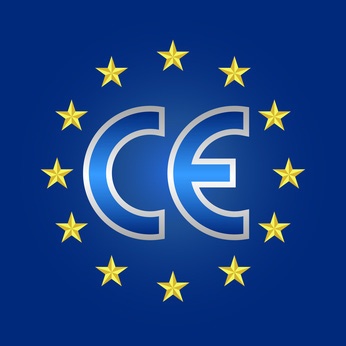The International Trade Blog International Sales & Marketing
Use the CE Marking When Exporting to the European Union
On: May 20, 2016 | By:  Prema Nakra |
5 min. read
Prema Nakra |
5 min. read
 The European Union (EU) is a massive market that takes great pride in unifying the region so products and services can flow throughout the market seamlessly. To achieve greater integration, the EU has adopted what it terms the CE Marking Directives. These directives insist that CE Marking is mandatory if your product falls in one of the defined categories stated in its directives.
The European Union (EU) is a massive market that takes great pride in unifying the region so products and services can flow throughout the market seamlessly. To achieve greater integration, the EU has adopted what it terms the CE Marking Directives. These directives insist that CE Marking is mandatory if your product falls in one of the defined categories stated in its directives.
In this article I will highlight the power of the EU in the world market and the importance of CE Marking to enter and sustain your international marketing operations. As always, I won't provide any legal counsel or advice.
EU Market Power
The European Union has one of world's largest economies with a 2014 Gross Domestic Product (GDP) of $18.495 trillion. According to 2015 statistics, the European Union consists of 28 sovereign states and more than 500 million people. In population ranking, the EU is third, behind China and India.
According to World Bank, the EU accounts for a substantial share of global trade. If the European Union continues to add new members, it may be only a matter of time before the European marketplace begins to challenge the United States as the premier business market in the world.
Doing Business with EU Member States: The European Union’s Agenda
The EU's goal has always been to develop a market in which goods can be traded without any internal trade restrictions. To accomplish this goal, the EU has adopted the harmonized European product legislation and CE Marking. In other words, to successfully tap these markets, exporters need to understand the procedure for application as well as the implications of the CE Marking. The resolution harmonizes national systems of European standards and promotes varied New Approach Directives. The directives state the requirements a product must have to be put on the market. The essential requirements are contained in the relevant directive, and products may need to comply with the requirements of more than one directive.
This article is focused on CE Marking since it is frequently being viewed as the passport to Europe.
What is CE Marking?
The CE Mark was conceived in 1985 by a New Approach Resolution in Europe and was made part of the European Community legislation two years later. According to some experts, CE does not have any meaning as an abbreviation, but may have originally stood for Communauté Européenne or Conformité Européenne, French for European Conformity.
On January 1, 1995, new EU directives came into effect requiring the CE mark on a wide range of products entering EU member states. While these directives aim at eliminating non-tariff barriers to trade within the EU system, products flowing through the EU must comply with general safety and environmental norms.
A CE Marking means the product meets the standards established by the 28-nation European Union and four-nation European Free Trade Association (EFTA) and qualifies the product for sale in those countries. CE marking on a product or system assumes conformity by the manufacturer or importer by complying with one or more directives relating to the product.
The CE Mark a particular form of testing or certification. It should not be confused with third-party certification marks. The CE Mark simply allows a product to be placed on the market within the European Community. And it gives the national administration members confidence that essential requirements of relevant directives have been met.
In a nutshell, only products with a CE Mark can be legally sold in the European Union. The CE Mark is required for manufacturers wishing to sell their products in the 28 EU countries. Many non-EU exporters are finding that no matter how interested a prospective EU importer may be in the product, the importer will not risk importing non-conforming products (i.e. the products without CE Marking) which, in case of accident, may generate legal action against them.
CE Marking Is Not Optional
Products that meet the essential requirements of safety, health, environment and consumer protection can bear the CE Mark, while companies that don't conform not only risk losing sales, but also face criminal prosecution. If a product does not bear a CE Mark, it may not lawfully be put on the market within the EU. This gives the CE Mark the status of a passport to the EU and explains why some producers from outside the EU may use the mark to mislead customs officers and gain access to EU markets. Additionally, distributors of such goods could be held responsible for ensuring they conform with the relevant EU safety directive.
The New Approach Directives documents contain the European Commisson legislation on the requirements that must be met and procedures that must be followed in order for a product to be CE Marked for sale in the EU. Upon review of these directives, if you find your product to be listed in the 22 products groups stated in the document, you must understand CE Marking. Products that need certification via CE Marking range from low voltage electrical equipment, toys, explosives, elevators and in-vitro medial devices. Detailed information is provided at the CE Marking official website.
The member states are responsible for surveillance of their domestic markets. If at any time a product does not meet the essential requirements, the authorities of a member state can order that the product be withdrawn from the market in that state. If a product that requires CE Marking finds its way via gray marketing or some other means into EU member country markets without CE conformity, it will be withdrawn from the market through official action. In such even, the manufacturer is obliged to modify the product so that it complies with all applicable directives before it can again be sold.
CE Marking Process
In simple words, CE marking means that the manufacturer verifies that the product meets the requirements of all new approach directives that apply to the product it is marketing in EU member states. It also means that the manufacturer confirms that the product has been assessed according to one of the prescribed procedures to determine that it fulfils the mandatory requirements.
In general, the steps to obtain CE Marking on these goods consist of:
- Identifying applicable directives and standards,
- Determining if the product meets all requirements of the applicable directives,
- Preparing a technical file,
- Preparing an EU Declaration of Conformity, and
- Affixing the CE Marking.
The CE Marking process includes a rigorous examination of quality manufacturing procedures and indicates to the public that the marked device meets standards set by the Union for products and medical devices. For a product made in the EU, the manufacturer may either carry out the necessary safety tests itself or use an independent testing house which has been certified by a competent authority.
Soon after the test is completed, a declaration of conformity to the essential requirements must be prepared. The Declaration of Conformity must contain information adequate for tracing the product back to the manufacturer or the authorized representative in the European Union. It may include a list the directives and standards that your product conforms to, product identification, the manufacturer's name, address, and signature.
After this, the manufacturer affixes a CE mark to his product. A technical file must be maintained containing approved documentation showing the manufacturer's reasoning as to how this product satisfies EU requirements. This must be kept for at least 10 years after the manufacture of the last unit of the product. Then the product may be placed on the European Community market without challenge by national administrations.
It is important to remember that there are specific rules that must be adhered to for the CE Marking. These rules address the size and location of the marking; affixing the CE Marking to products, packaging, and material or documents shipped with the product; and specific limitations on when and who is permitted to affix the CE Marking.
Final Words
The CE Mark proves to buyers that the product fulfills all the essential safety and environmental requirements as defined in the European Directives. As long as your products are affixed with CE Marking, importers, distributors and sales representatives will find it easier to do business with you since they won't have to deal with complex conformity issues and product certification that requires professional in-depth expertise.
This post was originally published in April 2007 and has been updated to include current information, links and formatting.

About the Author: Prema Nakra
Prema Nakra, Ph.D. is an educator, economist and a marketing consultant. Dr. Nakra is a professor of marketingand International Business and MBA Program Director at the School of Management, Marist College. Her academic qualifications include a Ph.D. in economics, MA in economics, and MBA in marketing management.
Prior to joining Marist, Dr. Nakra worked for international organizations including the International Cooperative Alliance for South East Asia, Ellington Duval Inc, Worldwide Marketing Group, and the New School for Social Research. An active member of American Marketing Association, American Economic Association, and Balanced Scorecard Technology Council, she is frequently invited to presents papers and at international business conferences.


